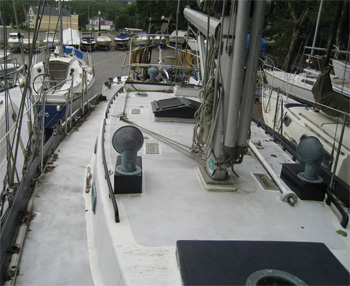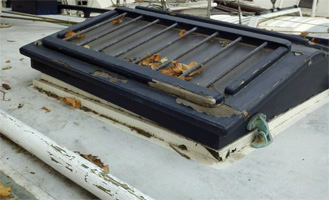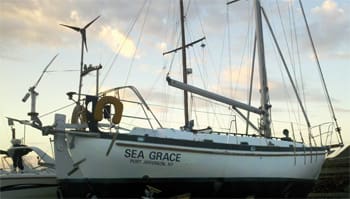To the editor: In the summer of 2009 my son Christopher and I were spending a lazy afternoon wandering around our local boatyard in Port Jefferson, N.Y. We were in the “bone yard” section, investigating the old abandoned boats, when we came across something special. The boat was a double-ender full keel boat with a wind generator and self-steering vane. The name on the hull was Sea Grace. This was a boat unlike any other we had seen that afternoon and we scrambled up on deck to take a closer look.
What we found was a boat that was clearly setup for ocean voyaging. She had a nice small cockpit and foot well which would not contain too much sea water from errant waves breaking over her stern. She had a tiller attached to a stern hung rudder and an interesting “mini” tiller atop of it, which was attached to a trim tab on the aft section of the rudder. The cockpit, while small, was comfortable with high seat backs angled outboard at about 15 degrees. There were two lockers built into the seat backs, and a high combing that shielded the helmsman from wind and water. There was one lazarette to the stern, but no lockers under cockpit seats.
There were five winches convenient to the cockpit for various sail sheets. The rig appeared to be new, with essentially no chafing visible on the aluminum boom or mast. And the standing rigging looked shiny with no rust stains visible around the Norseman swages. There was extensive use of bronze for hardware which was green with age, but clearly very solid. There was a roller furling rig on the headstay and a cutter rig for a staysail. There was a wooden bowsprit with two anchor rollers, and a large spool of anchor rope permanently mounted forward of the cabin on the bow. While the rig looked new, it was clear that the boat had been exposed for several years. There were leaves on deck that had composted into earth from which small trees were sprouting. The entire boat was painted, but the paint was peeling and everything had a good layer of dirt and grime on it. We kicked away some of the dirt and the deck below felt solid with no sponginess.
 |
|
The deck of Sea Grace/Nada shows signs of wear and weathering. |
We found two additional locations for mounting anchors on the stern pushpit. This boat was clearly not well suited to spending time in a slip. It was designed and built to be at sea. And by the look of the ground tackle setup, when it did approach land it would be anchoring.
How did this boat end up in the bone yard? I imagined that the owner may have come into port and fallen ill, possibly passing away, and the boat was abandoned. We wanted to know more about this story. As we were about to climb down I noticed a small bronze porthole in the cabin roof which was dogged down from above. I took the liberty of opening the porthole and peered below into the dark. The porthole seemed to be a vent above the galley. I inserted my nose and drew in a deep breath. She was dry. For all the rainwater, snow and weather abuse she took on the outside, the interior seemed to have been protected. This was one well-built boat.
As we climbed down I realized I was beginning to refer to Sea Grace as “her” rather than “it.” At the boatyard office they said that she had been in the yard for several years and that Sea Grace was not her original name. They said she was built by some famous writer and her name was originally Nada. My jaw dropped! Was this actually Nigel Calder’s famous boat that I knew of from so many magazine articles? They said that the current owner had not been to the yard in several years and they would try to reach him to see what his intentions for the boat were.
 |
|
Peeling paint on Sea Grace/Nada’s deck hatch revealed the boat was in need of an overhaul. |
I checked back with the boatyard several times over the following weeks, but each time there was no response from the owner. Finally, we discovered that a bank had begun repossession activities. The boatyard in turn blocked her in with other boats. They rightfully wanted their yard fees too, and were not going to let her go without satisfaction.
Sea Grace, exposed to the elements, continued to deteriorate. I discussed all this with a small group of friends from the tall ship community while we were out on a day sail together and we determined that we had to do whatever we could to save the boat.
The yard agreed to unlock the hatch and allow us to inspect the interior. We were looking for any signs of problems, but also for anything that would confirm that this was in fact Nigel Calder’s Nada. The interior was dry and sound. The butterfly hatch had been secured in a slightly open position and a small amount of driving rain or maybe melting snow had dripped on the cushions, staining them. But there was no indication of any structural leaking through the deck or seams. Then we found the evidence we were hoping for. In the forward cabin were sail bags. One of the sail bags had a tag with Nigel C. written on it! Wow! We also found a ring of keys with a fob from New Orleans, and the aluminum propane tanks had NADA written on them. We were now sure we knew what we were dealing with.
Finally, after much delay and then negotiations, on Dec. 16, 2010, we got the U.S. Coast Guard documents that secured our ownership. On Dec. 17 we covered the boat with tarps to protect her for the winter.
For the past three years we’ve been slowly refurbishing her as time and money allows. Rather than retain her as a private yacht, we decided to form Sailing Nada Adventures with the mission of sail training and youth leadership development. We think she’s the perfect platform to transform lives. And we plan for her to go offshore again where she will be in her element.
————
Roger Noakes is an avid lifelong sailor and entrepreneur who has successfully operated his own businesses since the late ‘90s. You can read more about the restoration of Nada at sailingnada.com.

